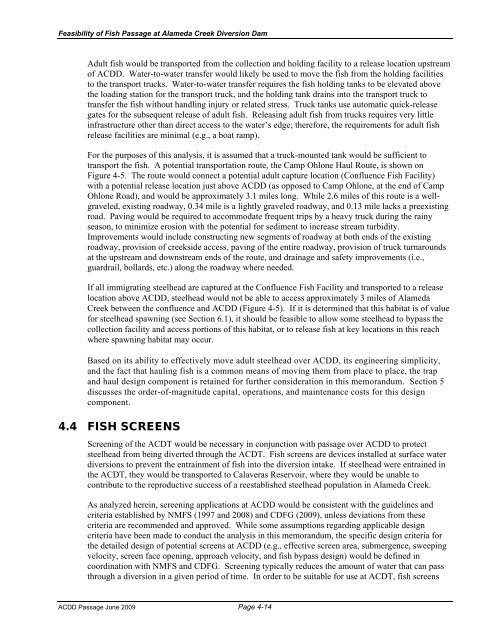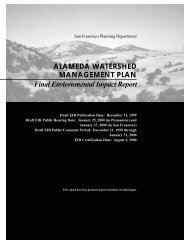Feasibility of Fish Passage at Alameda Creek Diversion Dam
Feasibility of Fish Passage at Alameda Creek Diversion Dam
Feasibility of Fish Passage at Alameda Creek Diversion Dam
Create successful ePaper yourself
Turn your PDF publications into a flip-book with our unique Google optimized e-Paper software.
<strong>Feasibility</strong> <strong>of</strong> <strong>Fish</strong> <strong>Passage</strong> <strong>at</strong> <strong>Alameda</strong> <strong>Creek</strong> <strong>Diversion</strong> <strong>Dam</strong>Adult fish would be transported from the collection and holding facility to a release loc<strong>at</strong>ion upstream<strong>of</strong> ACDD. W<strong>at</strong>er-to-w<strong>at</strong>er transfer would likely be used to move the fish from the holding facilitiesto the transport trucks. W<strong>at</strong>er-to-w<strong>at</strong>er transfer requires the fish holding tanks to be elev<strong>at</strong>ed abovethe loading st<strong>at</strong>ion for the transport truck, and the holding tank drains into the transport truck totransfer the fish without handling injury or rel<strong>at</strong>ed stress. Truck tanks use autom<strong>at</strong>ic quick-releaseg<strong>at</strong>es for the subsequent release <strong>of</strong> adult fish. Releasing adult fish from trucks requires very littleinfrastructure other than direct access to the w<strong>at</strong>er’s edge; therefore, the requirements for adult fishrelease facilities are minimal (e.g., a bo<strong>at</strong> ramp).For the purposes <strong>of</strong> this analysis, it is assumed th<strong>at</strong> a truck-mounted tank would be sufficient totransport the fish. A potential transport<strong>at</strong>ion route, the Camp Ohlone Haul Route, is shown onFigure 4-5. The route would connect a potential adult capture loc<strong>at</strong>ion (Confluence <strong>Fish</strong> Facility)with a potential release loc<strong>at</strong>ion just above ACDD (as opposed to Camp Ohlone, <strong>at</strong> the end <strong>of</strong> CampOhlone Road), and would be approxim<strong>at</strong>ely 3.1 miles long. While 2.6 miles <strong>of</strong> this route is a wellgraveled,existing roadway, 0.34 mile is a lightly graveled roadway, and 0.13 mile lacks a preexistingroad. Paving would be required to accommod<strong>at</strong>e frequent trips by a heavy truck during the rainyseason, to minimize erosion with the potential for sediment to increase stream turbidity.Improvements would include constructing new segments <strong>of</strong> roadway <strong>at</strong> both ends <strong>of</strong> the existingroadway, provision <strong>of</strong> creekside access, paving <strong>of</strong> the entire roadway, provision <strong>of</strong> truck turnarounds<strong>at</strong> the upstream and downstream ends <strong>of</strong> the route, and drainage and safety improvements (i.e.,guardrail, bollards, etc.) along the roadway where needed.If all immigr<strong>at</strong>ing steelhead are captured <strong>at</strong> the Confluence <strong>Fish</strong> Facility and transported to a releaseloc<strong>at</strong>ion above ACDD, steelhead would not be able to access approxim<strong>at</strong>ely 3 miles <strong>of</strong> <strong>Alameda</strong><strong>Creek</strong> between the confluence and ACDD (Figure 4-5). If it is determined th<strong>at</strong> this habit<strong>at</strong> is <strong>of</strong> valuefor steelhead spawning (see Section 6.1), it should be feasible to allow some steelhead to bypass thecollection facility and access portions <strong>of</strong> this habit<strong>at</strong>, or to release fish <strong>at</strong> key loc<strong>at</strong>ions in this reachwhere spawning habit<strong>at</strong> may occur.Based on its ability to effectively move adult steelhead over ACDD, its engineering simplicity,and the fact th<strong>at</strong> hauling fish is a common means <strong>of</strong> moving them from place to place, the trapand haul design component is retained for further consider<strong>at</strong>ion in this memorandum. Section 5discusses the order-<strong>of</strong>-magnitude capital, oper<strong>at</strong>ions, and maintenance costs for this designcomponent.4.4 FISH SCREENSScreening <strong>of</strong> the ACDT would be necessary in conjunction with passage over ACDD to protectsteelhead from being diverted through the ACDT. <strong>Fish</strong> screens are devices installed <strong>at</strong> surface w<strong>at</strong>erdiversions to prevent the entrainment <strong>of</strong> fish into the diversion intake. If steelhead were entrained inthe ACDT, they would be transported to Calaveras Reservoir, where they would be unable tocontribute to the reproductive success <strong>of</strong> a reestablished steelhead popul<strong>at</strong>ion in <strong>Alameda</strong> <strong>Creek</strong>.As analyzed herein, screening applic<strong>at</strong>ions <strong>at</strong> ACDD would be consistent with the guidelines andcriteria established by NMFS (1997 and 2008) and CDFG (2009), unless devi<strong>at</strong>ions from thesecriteria are recommended and approved. While some assumptions regarding applicable designcriteria have been made to conduct the analysis in this memorandum, the specific design criteria forthe detailed design <strong>of</strong> potential screens <strong>at</strong> ACDD (e.g., effective screen area, submergence, sweepingvelocity, screen face opening, approach velocity, and fish bypass design) would be defined incoordin<strong>at</strong>ion with NMFS and CDFG. Screening typically reduces the amount <strong>of</strong> w<strong>at</strong>er th<strong>at</strong> can passthrough a diversion in a given period <strong>of</strong> time. In order to be suitable for use <strong>at</strong> ACDT, fish screensACDD <strong>Passage</strong> June 2009 Page 4-14








